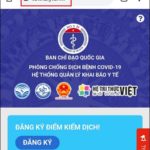The new CCCD with embedded chips has been adopted by several departments for its convenience, prompting many citizens to inquire about the procedure for converting their old ID cards to the new chip-based ones. To learn how to obtain the new CCCD, please refer to the following article.
1 What You Need to Know About the New CCCD
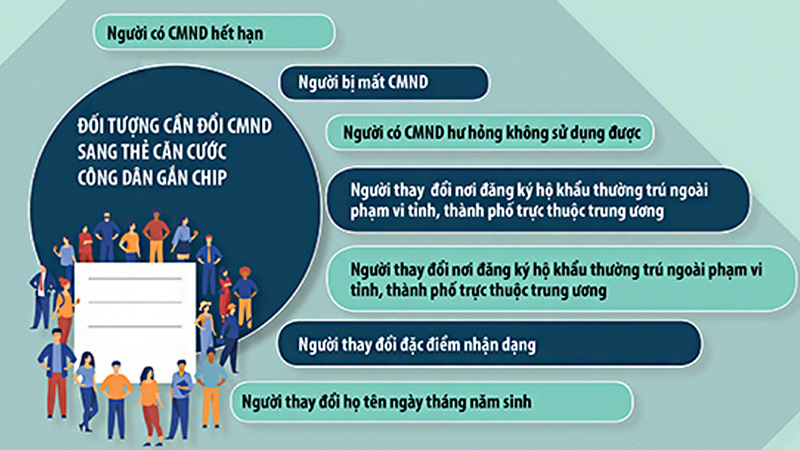 Important Information About the New CCCD
Important Information About the New CCCD
As per the Prime Minister’s approval in Decision 1368/QD-TTg, the issuance of the new CCCD with embedded chips commenced in January 2021.
Who Needs to Exchange Their Old ID Cards for the New CCCD?
-
Individuals with a lost or damaged National ID card or CCCD.
-
Citizens who need to update their personal information or biometric data.
-
Vietnamese citizens aged 14 and above – eligible for new CCCD issuance (Clause 1, Article 19 of the Law on Citizen Identification 2014).
-
Citizens aged 25, 40, and 60 – eligible for renewal due to expiration (Clause 1, Article 21 of the Law on Citizen Identification 2014).
Benefits of Switching to the New CCCD
-
Enhanced storage capacity for citizen information.
-
Easy data linkage with health insurance, driver’s license, tax information, etc.
-
Streamlined administrative procedures with a single CCCD card.
What Happens if the New CCCD Is Lost?
According to the Ministry of Public Security, the chip’s security features are highly advanced, allowing only the card owner to use it. This prevents unauthorized transactions by impostors.
Do Other Documents Need to Be Updated When Switching to the New CCCD?
As per the Ministry of Public Security, the new card’s QR code will include the old card number, eliminating the need to update other documents.
2 Steps to Exchange Your Old ID Card for the New CCCD
For a smoother process, citizens are advised to contact the competent authorities, such as the people’s committees at different levels, to inquire about the procedure for exchanging their old ID cards for the new CCCD.
Step 1: Complete the Citizen Identification Form
 Apply Directly at the Local Police Station
Apply Directly at the Local Police Station
– Option 1: Citizens can apply directly at the local police station’s Administrative Management Division for Social Order, or at the County-level Public Security Office or the Public Security Office’s One-Stop Service Section (if the new CCCD has been implemented in the citizen’s district). This option applies to both those who wish to update their information and those who do not.
– Option 2: To save time, you can complete the electronic declaration on the National Public Service Portal (applicable only if you are not changing your information or if the changes have already been updated in the National Database of Population).
Step 2: Present Your Old ID Card and Follow the Instructions
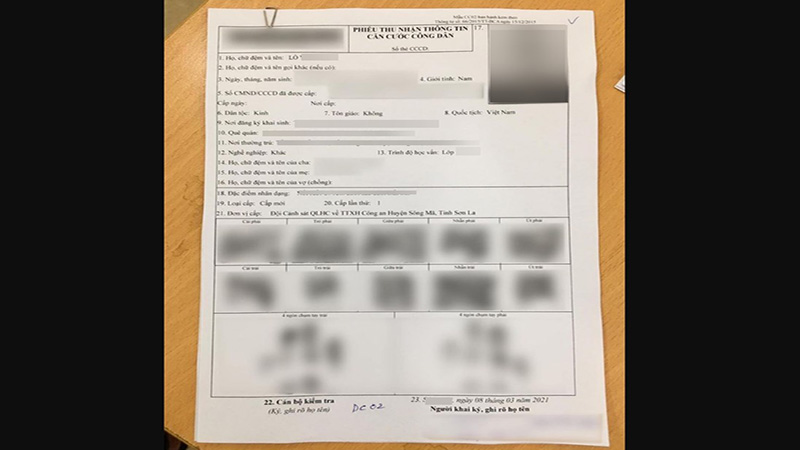 Proceed with the ID Card Exchange
Proceed with the ID Card Exchange
When applying for the new CCCD, present your old ID card (National ID card or CCCD). For added convenience, you may also bring your household registration book or other personal documents (such as a birth certificate or passport).
Next, the official in charge will verify your information from the CCCD Receipt Form in the CCCD issuance software, which has been updated and synchronized with the National Database of Population, to confirm your identity and ensure data consistency.
Note: If your information has changed and has not been updated in the National Database of Population, you must present valid documents reflecting those changes.
Once the official deems your documents sufficient and your application eligible, they will take your photograph and collect your fingerprints (via a fingerprint scanner) and other biometric data. In cases where a finger is missing, deformed, or otherwise unable to provide fingerprints, the official will make a specific note in the corresponding finger field.
Upon completion of data collection, the information will be printed on the CCCD Receipt Form and the CCCD card as per regulations.
Step 3: Pay the Prescribed CCCD Fee
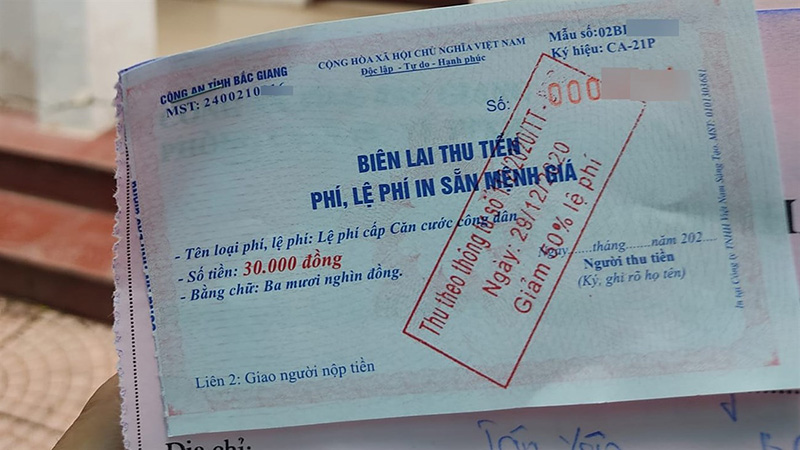 Pay the Prescribed CCCD Fee
Pay the Prescribed CCCD Fee
According to Circular 112/2020/TT-BTC, from January 1, 2021, to June 30, 2021, the fee for the new CCCD with a chip is 50% of the standard fee specified in Article 4 of Circular 59/2019/TT-BTC (regulating the collection, payment, and management of fees for the issuance of Citizen Identification Cards).
Starting July 1, 2021, the fee will be as specified in Circular 59/2019/TT-BTC.
For the conversion from the old 9-digit or 12-digit ID cards to the new CCCD, the fee from January 1, 2021, to June 30, 2021, is VND 15,000 per CCCD. From July 1, 2021, the fee will be VND 30,000 per CCCD.
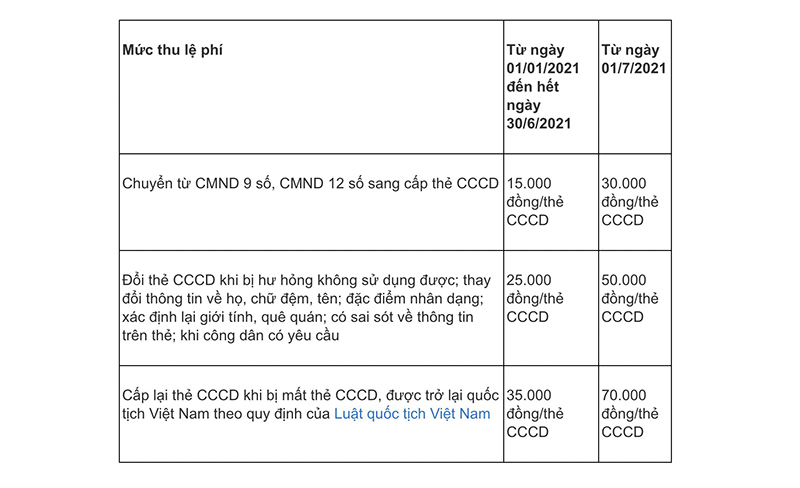 Summary of CCCD Fee Structure
Summary of CCCD Fee Structure
For replacement of a damaged CCCD, changes in name, biometric data, or gender, or correction of errors on the CCCD, the fee from January 1, 2021, to June 30, 2021, is VND 25,000 per CCCD. From July 1, 2021, the fee will be VND 50,000 per CCCD.
For reissuance of a lost CCCD or for individuals who have regained Vietnamese nationality as per the Law on Vietnamese Nationality, the fee from January 1, 2021, to June 30, 2021, is VND 35,000 per CCCD. From July 1, 2021, the fee will be VND 70,000 per CCCD.
– Exemptions from the Fee:
-
CCCD replacement due to changes in administrative boundaries as stipulated by the State.
-
CCCD issuance or replacement for fathers, mothers, wives, husbands, or children under 18 years of age of martyrs; war invalids; people entitled to preferential treatment as war invalids; children under 18 years of age of war invalids and people entitled to preferential treatment as war invalids; disabled soldiers; citizens permanently residing in border communes; citizens permanently residing in island districts; ethnic minorities in communes with particularly difficult socio-economic conditions; citizens from poor households as defined by the law.
-
CCCD issuance or replacement for orphans under 18 years of age with no guardians.
-
Citizens aged 14 and above applying for their first CCCD as per Clause 1, Article 19, and Clause 2, Article 32 of the Law on Citizen Identification.
-
CCCD replacement upon reaching the age specified in Article 21 and Point a, Clause 3, Article 32 of the Law on Citizen Identification.
-
CCCD replacement due to errors caused by the CCCD management agency.
Step 4: Receive Your CCCD Appointment Slip
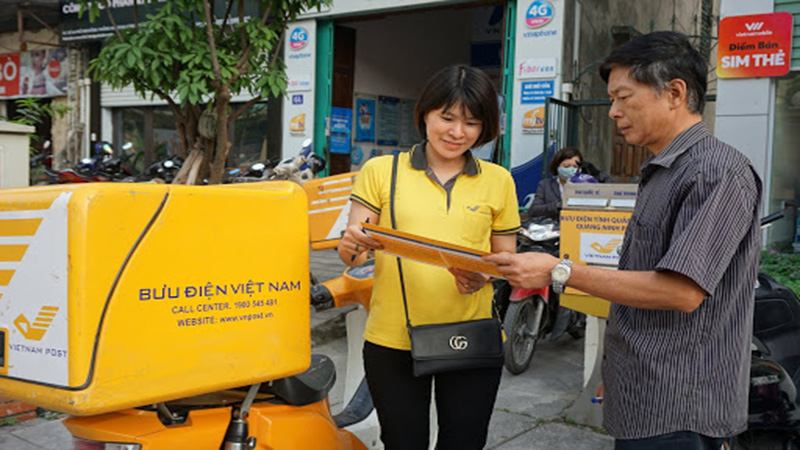 Obtain Your CCCD Appointment Slip
Obtain Your CCCD Appointment Slip
– Case 1: In-Person CCCD Collection at the Registration Authority
For clear and legible old ID cards (9-digit, 12-digit, or CCCD with a barcode), the official will verify the information on the system, make any necessary updates, and return the old ID card along with an appointment slip for the new CCCD.
If the old ID card is damaged or peeling, the official will collect and destroy it, make a note in the file, and provide a confirmation of the ID number.
Subsequently, citizens must present the appointment slip when collecting their new CCCD. The official will cut off the upper right corner of the old ID card (2 cm for 9-digit ID cards and 1.5 cm for 12-digit ID cards and CCCD with a barcode) before returning it to the citizen.
– Case 2: CCCD Delivery to a Specified Address
If the old card is clear and legible, the CCCD management agency will cut off the corner and return the old ID card immediately upon receiving the application.
For damaged or peeling old ID cards, the official will collect and destroy the card, make a note in the file, and provide a confirmation of the ID number.
The management agency will then coordinate with the postal service to deliver the new CCCD to the specified address, and citizens will be required to pay the postage as per regulations.
Note: The new circular from the Ministry of Public Security does not specify a resolution time frame, unlike previous regulations regarding CCCD issuance, exchange, and reissuance.
3 Important Notes on Converting Your Old ID Card to the New CCCD
 Key Considerations When Converting to the New CCCD
Key Considerations When Converting to the New CCCD
According to Article 11 of the Draft Circular guiding a number of articles and measures for implementing the Law on Citizen Identification, Decree No. 137/2015/ND-CP:
– The photo on the new CCCD must be a color photo with a white background, taken straight-on, showing the full face and both ears, without glasses; attire and demeanor must be serious and polite, and sectoral uniforms are not allowed. Religious or ethnic minorities may wear their respective religious or ethnic attire.
– Fingerprints will be collected via a machine, including four-finger slaps of the right and left hands, two-thumbprints, and individual fingerprints. In cases where a finger is missing, deformed, or otherwise unable to provide fingerprints, a specific note will be made in the corresponding finger field.
– For citizens who have been issued a CCCD but have not received or have lost their National ID number confirmation, the following steps should be taken:
Step 1: Submit a written request for the confirmation of the National ID number, and present the original and a copy of the CCCD, along with a copy of the old 9-digit ID card (if available), to the official in charge of CCCD management at the CCCD issuance, exchange, or reissuance location.
Step 2: The CCCD management official will verify the information. If it is valid, they will accept the request and issue an appointment slip. If it is invalid, they will provide a written response stating the reason.
Note: The time limit for issuing the National ID number confirmation is 7 working days from the date of receiving the complete application.
4 Actual Images of the New CCCD with a Chip
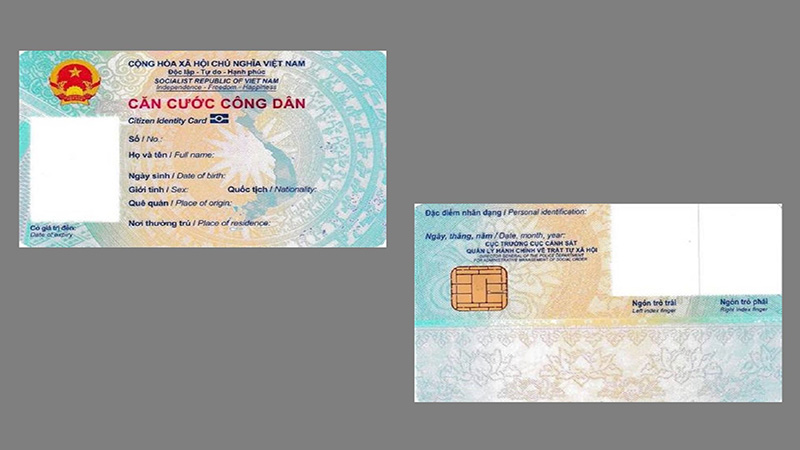 Real-Life Images of the New CCCD with a Chip
Real-Life Images of the New CCCD with a Chip
The new CCCD card design remains unchanged from the previously published sample. The embedded electronic chip (similar to the back of a SIM card) facilitates faster citizen identification and authentication, providing quick access to the National Database of Population.
5 Frequently Asked Questions About the New CCCD
Q: Do I Need to Exchange My Newly Issued ID Card for the New CCCD?
A: Yes, you will need to switch to the new CCCD with a chip in the future. The new CCCD will eventually replace the old ID cards. However, for now, the old ID cards remain valid, and you can continue using them for administrative procedures unless you have an urgent need to switch.
Q: What Documents Do I Need to Bring When Applying for the New CCCD? Is the Process Quick?
A: Bring your household registration book and old ID card for information lookup. Your personal information should already be updated in the National Database of Population, linked to your household registration book and old ID card. However, it’s best to bring them just in case. The process involves information lookup, fingerprinting, and on-site photography and typically takes about 15 minutes per person.
Q: Is There a Fee for the New CCCD?
A: Yes. However, you will only pay when you receive the new CCCD. The fee is currently discounted by 50%. The standard fees are: VND 15,000 for new issuance, VND 25,000 for replacement, and VND 35,000 for reissuance.
Q: My Old ID Card Is
Explore 12 Amazing Destinations for Biking Trips
Unlock Vietnam in a brand new way with an exciting biking tour! Discover the stunning beauty of the country with Dien May XANH’s top 12 must-see destinations. From sweeping plains to clear blue beaches and mountainous vistas – experience all the sights with your own personal cycling tour. Find your ideal route and set out for an adventure today!




























